What is non-probability sampling?
Non-probability sampling (sometimes nonprobability sampling) is a branch of sample selection that uses non-random ways to select a group of people to participate in research.
Unlike probability sampling and its methods, non-probability sampling doesn’t focus on accurately representing all members of a large population within a smaller sample group of participants. As a result, not all members of the population have an equal chance of participating in the study.
In fact, some research would deliver better results if non-probability sampling was used. For example, if you’re trying to access hard-to-reach social groups that aren’t usually visible, then a representative sample wouldn’t yield suitable candidates.
Instead, you may opt to select a sample based on your own reasons, including subjective judgment, sheer convenience, volunteers, or – in the above example – referrals from hidden members of society willing to speak out.
Free eBook: 2024 global market research trends report
When do you use non-probability sampling?
Non-probability sampling is typically used when access to a full population is limited or not needed, as well as in the following instances:
- You may want to gain the views of only a niche or targeted set of people, based on their location or characteristics. To ensure that there is plenty of data about the views of these specific people, it would make sense to have a sample full of people meeting the criteria.
- If there is a target market that you want to enter, it may be worthwhile doing a small pilot or exploratory research to see if new products and services are feasible to launch.
- If money and time are limited, non-probability sampling allows you to find sample candidates without investing a lot of resources.
- Where members are not represented traditionally in large populations or fly under the radar, like far-left and right-wing groups, it’s necessary to approach these subjects differently.
What’s the difference between non-probability and probability sampling?
Random vs deliberate choice
Probability sampling, also known as random sampling, uses randomization rather than a deliberate choice to select a sample. This representative sample allows for statistical testing, where findings can be applied to the wider population in general.
What about non-probability sampling?
Non-probability sampling techniques, on the other hand, pick items or individuals for the sample based on your goals, knowledge, or experience. This eliminates the chance of users being picked at random but doesn’t offer the same bias-removal benefits as probability sampling.
Fair chance vs stacked chance
With probability sampling, there is an equal and fair chance of each member of the population being picked to be part of the smaller sample.
What about non-probability sampling?
Conversely, in non-probability sampling, participants don’t have an equal chance of being selected. Instead, participants who hold desirable characteristics that fulfill your requirements are more likely to be selected.
Full knowledge of the population vs varying knowledge of the population
Probability sampling techniques require you to know who each member of the population is so that a representative sample size can be chosen. The population acts as the sampling frame — without it, creating a truly random sample can be difficult.
What about non-probability sampling?
Non-probability sampling doesn’t need to know each member of the population before sampling. In some probability sampling methods, the sample grows on its own (snowballing) and sample participants can be sourced from one setting or location (convenience), irrespective of the total population.
Objectivity vs depth
Probability sampling aims to be objective in its sample selection method; it tries to remove bias by randomizing the selection and making it representative. Along with qualitative data, you’re more likely to get quantifiable data that can be scaled up to make models.
What about non-probability sampling?
Non-probability sampling is the opposite, though it does aim to go deeper into one area, without consideration of the wider population. The level of detail in qualitative data will be greater, though any quantitative data is confined to the boundaries of that specific group and is hard to scale to other people in the population.
Faster to sample vs harder to sample
Probability sampling requires that a proportionate sample quota of representative yet diverse people be selected before the research can begin. This can be hard to do when response rates are low or there are no incentives to get involved.
What about non-probability sampling?
Non-probability sampling avoids this problem. As the sample only needs to have the right amount of people before the research can begin, participant sourcing methods can be more creative and varied.
Also, as the ideal candidates will have similar traits, once you understand where to attract them from, you can repeat the process until you have the sample size you need.
Advantages of non-probability sampling
- This branch can be used where no sampling frame (full details of the total population) is known.
- It provides detailed descriptions about the sample in question, meaning if your research is interested in qualitative takeaways, non-probability sampling can provide you with more insights.
- It’s quick and cheap to carry out. You only need to invest a small amount of time to gather a sample size you feel is appropriate before you begin your research.
- It does not fall subject to low response rates — a common issue for probability sampling techniques.
- It can be a quick starting point to investigate or explore if there is an issue among a specific audience group or target market, leading to more investment or further research opportunities.
- The ability to connect with under-represented, hidden, or extreme groups makes this appealing for researchers interested in understanding niche viewpoints.
- In an online world, non-probability sampling becomes even easier to conduct, as the ability to connect with targeted sample members is faster and not constrained by physical geography.
- You and your researchers can react in real-time, meaning that analysis and research into world events can occur quicker.
Disadvantages of non-probability sampling
- The largest disadvantage would be the presence of sampling bias as the sample selection method gives an unfair advantage to certain members of a population.
- The results from non-probability sampling are not easily scaled up and used to make generalizations about the wider population.
- In some methods, such as volunteer or convenience sampling, samples can be filled with people who are more likely to agree to want to be part of research because they hold strong views that they want to share. This can skew the validity of the results.
- As you choose deliberate selection criteria to use to assess the suitability of participants for a sample, this can result in researcher or selection bias. Your views and opinions could influence the sample, which in turn, impacts the findings of the research.
- The sample may be subject to pre-screening checks or other hurdles that make it hard for some selected participants to get into the sample itself. This further adds complicated layers that could exclude suitable candidates from ending up in the sample.
- Since there is no way to measure the boundaries of a research-relevant population, the sample size is also unclear. You may find you need more participants or less at a later stage, which could waste time and money.
Types of non-probability sampling
There are four types of non-probability sampling techniques: convenience, quota, snowball and purposive — each of these sampling methods then have their own subtypes that provide different methods of analysis:
1. Convenience sampling (also called haphazard, grab, opportunity, or accidental sampling)
Convenience sampling is a common type of non-probability sampling where you choose participants for a sample, based on their convenience and availability.
You can see this type being used in public places, like malls or school campuses, where it’s easy to meet and select people as they ‘go by’ based on the characteristics and criteria that you think are important.
It is a cheap and quick way to collect people into a sample and run a survey to gather data. Because of this, it is usually used for quick user opinion polls or pilot testing.
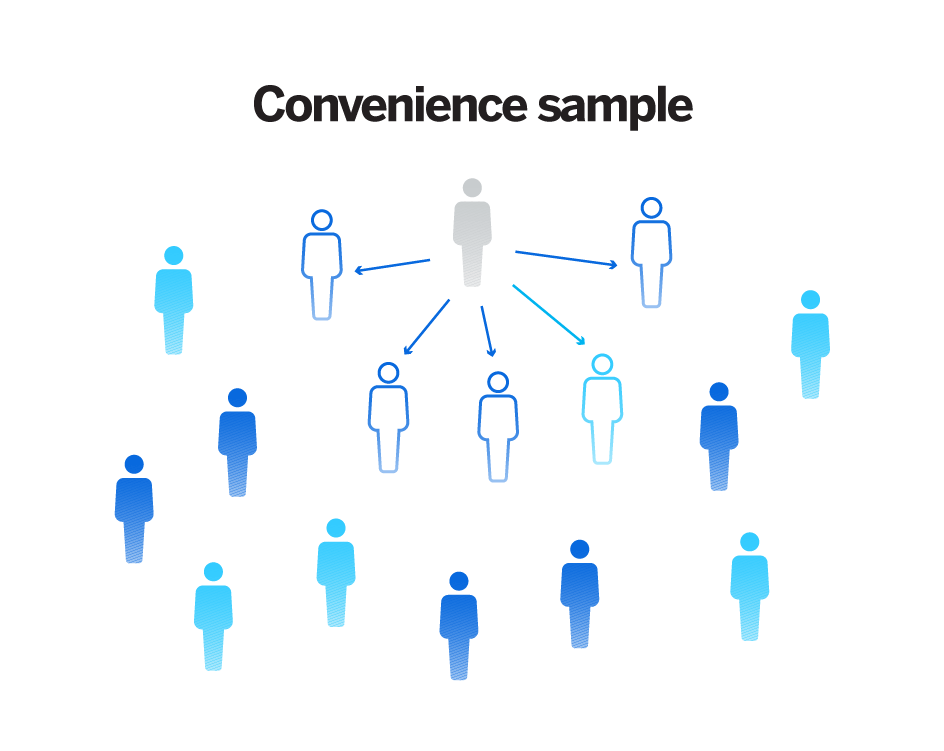
Convenience sampling also has two subtypes:
Consecutive sampling (also known as total enumerative sampling)
Consecutive sampling is the process of doing research with the sample members that meet the inclusion criteria and are conveniently available. You conduct research one after the other until you reach a conclusive result. Samples are chosen based on availability and each result is analyzed before you move onto the next sample or subject.
Self-selection (also known as volunteer sampling)
The self-selection sampling technique uses volunteers to fill in the sample size until it reaches a specified amount.
This requires less work contacting people, as volunteers sign up and opt-in to be part of the research if they meet your desired criteria. The insights gained will likely be based on strongly held opinions that these volunteers want to share. An example is medical research candidates that opt into medical studies because they fit the criteria of the research study and want to be involved for health reasons.
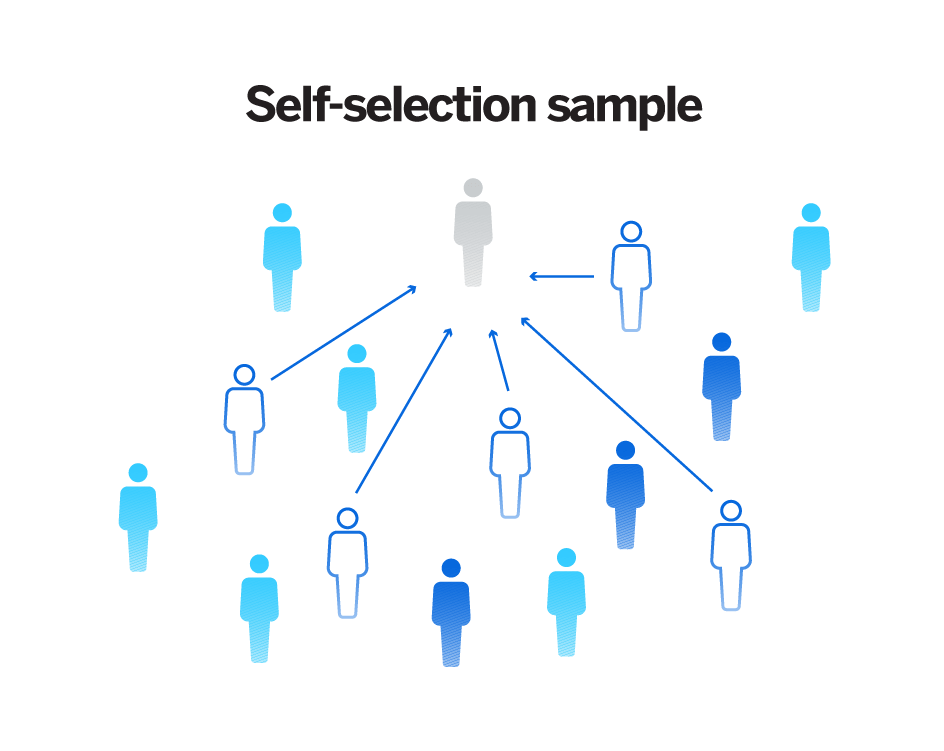
2. Quota sampling (also known as dimension sampling)
Quota sampling is a non-probability sampling technique similar to stratified sampling. In this method, the population is split into segments (strata) and you have to fill a quota based on people who match the characteristics of each stratum.
There are two types of quota sampling:
- Proportional quota sampling gives proportional numbers that represent segments in the wider population. For this, the population frame must be known.
- Non-proportional quota sampling uses stratum to divide a population, though only the minimum sample size per stratum is decided.
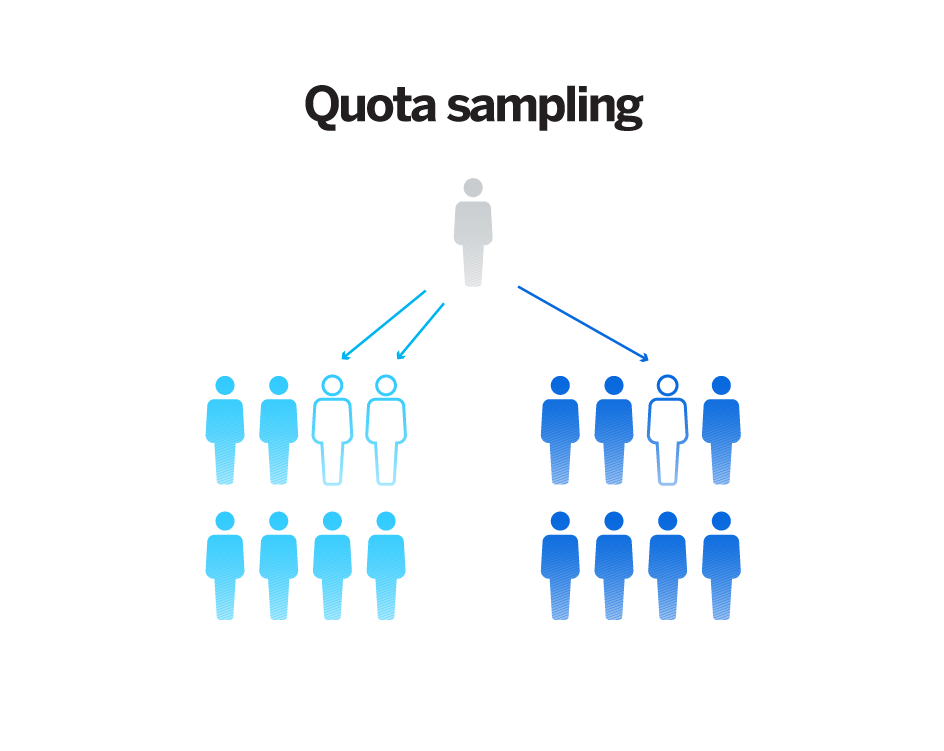
However, quota sampling techniques differ from probability-based sampling as there is no commitment from you to give an equal chance of participants being selected for the sample. Instead, you keep reaching out until the number in the stratum has been reached.
In general, quota sampling is conscious of the divisions in a population but still gives deep insights into each stratum.
3. Snowball sampling (also known as referral, respondent-driven, or chain referral sampling)
Snowball sampling is a non-probability sampling type that mimics a pyramid system in its selection pattern. You choose early sample participants, who then go on to recruit further sample participants until the sample size has been reached. This ongoing pattern can be perfectly described by a snowball rolling downhill: increasing in size as it collects more snow (in this case, participants).
This type of sampling is useful for getting in touch with hard-to-access communities of people, like sex workers, homeless people, or teenagers. An example of snowball sampling is recruiting sample members through social media channels who then promote your work to those in their network.
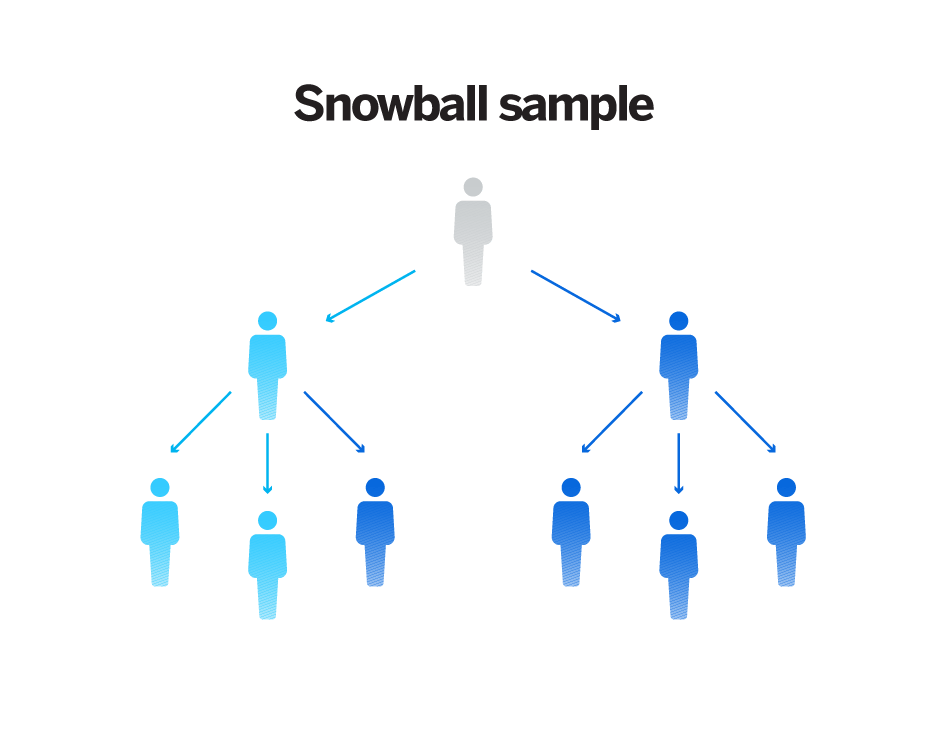
With this model, you are relying on who your initial sample members know to fulfill your ideal sample size. This can be quick to do when the chain of members develops past the first few levels. However, it does rely on the first members referring the research work to others.
Want to unlock more breakthrough insights? Use our research services and panels. With our proprietary online sample, you can get insights from any audience around the world and accurately track trends and shifts in your market over time.
4. Purposive sampling (also known as judgmental, selective, or subjective sampling)
Purposive sampling is a type of non-probability sampling where you make a conscious decision on what the sample needs to include and choose participants accordingly. In this way, you use your understanding of the research’s purpose and your knowledge of the population to judge what the sample needs to include to satisfy the research aims.
You must validate whether a prospective sample member fits the criteria you’re after, though if this is confirmed, the participant can be added to the sample. There are obvious bias issues with this type of sample selection method, though you have all the freedom to create the sample to fit the needs of your research.
That said, your credibility is at stake; even the smallest of mistakes can lead to incorrect data. However, because this is a fast and easy way to source a sample, you can redo the sample quite easily if there is a mistake.
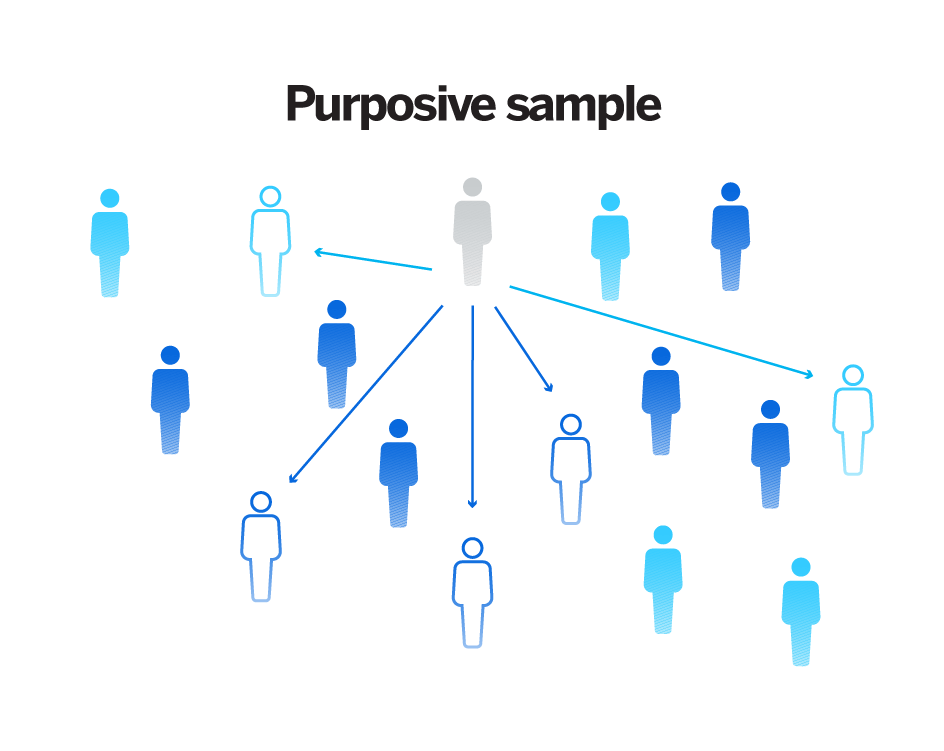
Some subtypes exist:
Heterogeneity sampling (also known as maximum variation sampling or sampling for diversity)
This is where you try to represent the widest range of views and opinions on the target topic of the research, regardless of proportional representation of the population. The main aims are to:
- make the research results as rich as they can be
- look at a topic from all perspectives
As such, having a broad spectrum of ideas from sample participants is key.
Homogeneous sampling (also known as modal instance sampling)
The opposite of heterogeneity sampling, homogenous sampling aims to get a sample of people who have similar or identical traits. For example, they might share the same views, beliefs, age, location, or employment. The traits selected are those that are useful to you in the research.
Instead of trying to see a topic from all angles, you focus on the research problem with a group of people who see it the same way and then go into detail.
Deviant sampling (also known as extreme sampling)
This is where you choose the sample based on cases or participant characteristics that are unusual or special in some way, such as outstanding successes or notable failures.
By allowing a group of non-traditional sample members to explore a topic, the insights will be unique and unpredictable, meaning that this could be valuable for ‘thinking outside the box’. Of course, you need to put in extra effort to find, connect and manage relationships with these sample members.
Expert sampling
When research goals call for a panel of specialists to help understand, discuss and elicit useful results, expert sampling could be useful. With expert sampling, the sample is chosen based on the knowledge of prospective sample members in a given area. This is best used in complex or highly technical research projects and where information is uncertain or unknown, though it can be used to validate other research findings by having an ‘expert’ vet the results.
Also, if you want to make sophisticated research easy, we can help. Just check out our solution that’s used by the world’s best brands to tackle research challenges and deliver the results that matter.
How to maximize your ROI
After reading through this guide, you should now have a better understanding of the different types of non-probability sampling techniques and how these sampling methods can be applied to your research.
But even with best practice, how can you maximize the ROI of the research that you do? With so much anxiety around financial and business health, many companies are reducing their research budgets and delaying projects. But with the speed at which consumers and employees are changing their behaviors, capturing insights and conducting targeted research has never been more important.
With access to real-time insights, you can empower your organization to make critical, data-driven decisions to drive breakthrough change. And this is where our eBook can help.
In it you’ll learn:
- How to improve research ROI through speed, agility, and consolidation
- Ways to get insights faster without sacrificing quality
- Tips for adjusting your research approach to be more nimble
Free eBook: 2024 global market research trends report